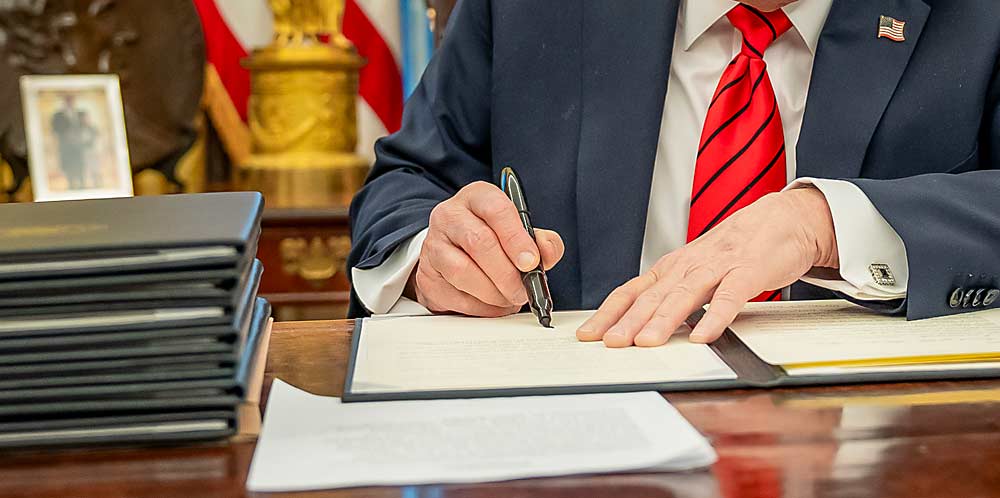One side effect of a career in journalism is a certain enthusiasm for breaking news, but to call the current news climate “fluid” would be an understatement.
The first few months of the new Trump administration have sparked so many fluctuating headlines that it’s hard even for our team of seasoned journalists to keep up, let alone everyone else with businesses to run and fruit to grow.
When I wrote the first draft of this column, I promised that we would explore the impacts of President Trump’s tariffs on top export markets in an upcoming issue of the magazine and online. Just before we sent this issue to the printer, though, another monthlong reprieve was announced for some of the tariffs on Mexican and Canadian goods.
A lot can change in the few weeks it takes for this magazine to be printed and delivered to your door, so in these pages, we remain focused on the big picture: what it takes to grow top-quality fruit and what industry leaders can offer about navigating a market and economy in flux. Meanwhile, on our website, we’re trying to keep up with the timely news relevant to our readers.
At this point, the ripple effects of tariffs on imports and retaliatory tariffs on exported fruit and wine remain uncertain. I traveled to British Columbia in February for an industry expo in Penticton, and many people there were eager to talk about the powerful “Buy Canadian” ethos developing in the country — and the potential implications in retailers’ produce sections. We’ll share more as we hear it.
Through all this uncertainty, the agriculture industry relies on a funded, functioning U.S. Department of Agriculture. Scientists are developing solutions to critical industry challenges, such as little cherry disease, codling moth control, and postharvest optimization to prevent food waste. Inspectors check for invasive species at our borders. Economists provide market data and analysis. Staffers help farmers navigate disaster payments and cost-share grants. USDA officials authorize phytosanitary procedures allowing fruit to be exported.
The mass firings put in jeopardy that agency’s ability to do work growers rely on. The “fire first and ask questions about how important these jobs were later” approach, which seems drawn from Elon Musk’s time in the startup world rather than good governance, has thrown remaining federal employees’ ability to do their work into chaos — not a state of greater efficiency.

“It feels like the point was to break us,” one USDA scientist told me, recounting the loss of colleagues and support staff, funding freezes and cuts, shifting directives and mass emails questioning their productivity.
The industry makes the value at which it holds USDA research apparent in the funding growers provide each year to scientists through the Washington Tree Fruit Research Commission, the Oregon Sweet Cherry Commission and the Washington State Wine Commission. As we have highlighted those research projects in the magazine, I’ve come to know many of these scientists and technicians who have spent years of their lives building a narrow expertise to make agriculture stronger.
When recent hires are fired, it’s a waste of all the resources spent to recruit, train and equip them to do this industry-supported and vital work. I’ve heard that industry advocacy has led to several scientists being reinstated, but the cuts to the USDA crossed every department (and seem to be continuing) and those as-yet-invisible impacts may also impact how growers do business.
In this fluid world, we’ll do our best to keep you informed.






Looking at the USA from the outside, I am very concerned for your top fruit sector, especially apples, as so many of those are exported. Apart from the tariffs, which may assist the industry in some indirect ways, through higher prices for imported fruits that you don’t grow (such as bananas), the outlook is not good.
Here in Ireland I am very familiar with the work of our dept. of Agriculture, in doing the kinds of things you described in the article, such as phytosanitary, running grants programs, releasing funds to research agencies, taking feedback from growers on regulatory change, licensing pesticides, monitoring water quality and so on. The people doing this work in Ireland are high committed, capable, and hardworking, and while there may be an odd person “taking it easy”, if they are, I’ve not encountered it. I would imagine the situation is not much different in the USA, and it’s really shocking that these teenage and twenty-something employees of Doge, who have no understanding of the work of the USDA, have been let loose, not so much to find waste, but to destroy the capacity of the organisation to deliver for growers, farmers, and the broader agricultural industry.
Many thanks for hearing me out, with this view from the outside looking in.